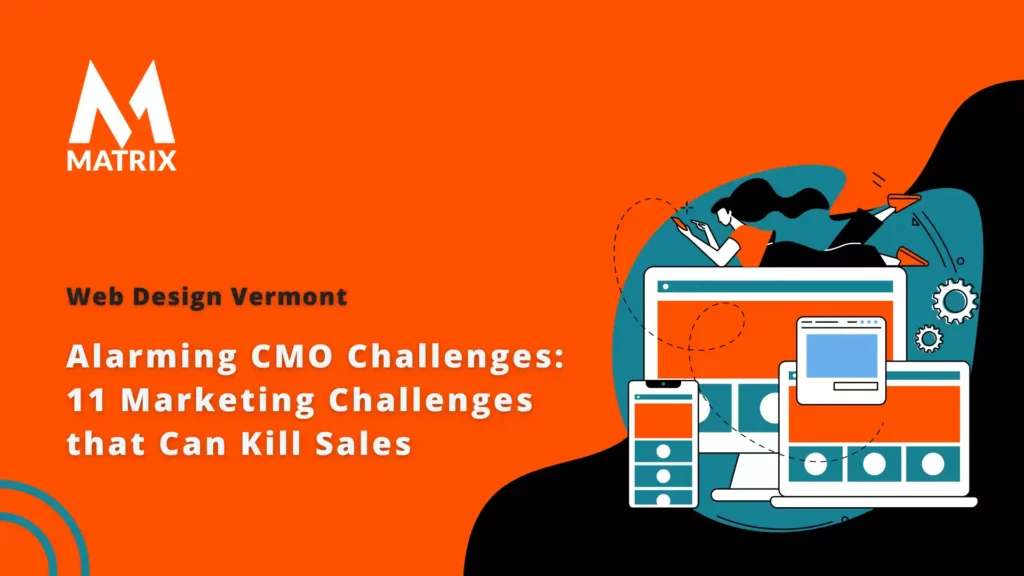CMO Challenges Being Faced in 2023
CMO challenges faced in 2023 are growing fast.
The marketing challenge faced by CMOs in 2023 is changing faster. The role of the Chief Marketing Officer has changed dramatically in recent years.
The CMO used to be primarily responsible for marketing strategy, but now they are tasked with much more. Marketing strategy is still a large part of their job, but it’s not all they do anymore.
They must take on many other roles, such as analytical problem solvers and understanding how data will affect future decisions to create an excellent user experience.
It is predicted in 2023 and 2024, the CMO will have a holistic approach to marketing strategy and adopt new technologies like AI integration into their workflows. The economic pressure will require cost-cutting and performance enhancements to stay competitive.
Introducing the New AI CMO: Driven by a Passion for the Customer Experience
In the rapidly evolving marketing and business landscape, one role has emerged as crucial for success: the Chief Marketing Officer (CMO). Traditionally responsible for overseeing marketing strategies and initiatives, the CMO plays a pivotal role in shaping a company’s brand identity and connecting with customers. However, as technology advances, a new breed of CMO has emerged – the AI CMO, driven by a passion for the customer experience.
The AI CMO is a revolutionary concept that combines the power of artificial intelligence with an unwavering focus on understanding and enhancing the customer experience. While traditional CMOs rely on intuition and experience, the AI CMO leverages data-driven insights, advanced analytics, and machine learning algorithms to deliver personalized, targeted, and impactful marketing campaigns.
At the heart of the AI CMO’s approach lies a deep understanding of customer behavior and preferences. By harnessing the power of AI, the CMO can analyze vast amounts of data collected from various sources, such as social media platforms, customer interactions, and purchase history. This wealth of information enables the AI CMO to gain valuable insights into customer needs, desires, and pain points, empowering them to create highly tailored marketing strategies.
Unlike its human counterpart, the AI CMO is not bound by biases or limited cognitive capacity. It can process immense volumes of data in real time, identifying patterns, trends, and correlations that would be difficult for a human to detect. Armed with this knowledge, the AI CMO can design and implement marketing campaigns that resonate with individual customers personally, fostering stronger connections and brand loyalty.
The AI CMO’s commitment to the customer experience goes beyond mere personalization. It seeks to understand the entire customer journey, from the initial point of contact to post-purchase interactions. By analyzing touchpoints, feedback, and sentiment analysis, the AI CMO can identify areas for improvement, optimize processes, and enhance overall customer satisfaction.

Moreover, the AI CMO’s ability to automate repetitive tasks and streamline marketing operations allows human marketing teams to focus on creativity, strategy, and relationship-building. By alleviating mundane tasks, the AI CMO empowers marketers to concentrate on high-value activities, such as crafting compelling narratives, designing innovative campaigns, and fostering authentic customer engagement.
Critics may argue that an AI CMO lacks a human CMO’s emotional intelligence and intuition, but the reality is that the AI CMO complements and augments human capabilities. By combining the power of technology with human creativity, innovation, and strategic thinking, the AI CMO enables companies to achieve a perfect synergy between data-driven insights and human intuition.
The rise of the AI CMO represents a paradigm shift in the marketing world, where customer experience takes center stage. By harnessing the capabilities of AI, companies can now deliver highly personalized experiences that cater to individual needs and preferences. The AI CMO’s passion for the customer experience revolutionizes how businesses connect with their target audience, creating deeper relationships and driving sustainable growth in an increasingly competitive marketplace.
Here are 11 challenges you might face if you’re a CMO in today’s competitive landscape!
What is a Chief Marketing Officer (CMO)?

The Chief Marketing Officer (CMO) is a senior executive position within a company or organization responsible for marketing its products or services. They oversee all marketing operations and develop marketing plans and strategies. The CMO typically reports to the CEO or President.
The CMO is responsible for various activities, including market research, product development, branding, pricing, advertising, and public relations.
They must deeply understand their customers and what they want and need. They also need to anticipate changes in the marketplace and adapt quickly to keep the company competitive.
To be successful as a CMO, you must have excellent leadership and communication skills and be creative and strategic.
You must also think analytically and use data to make informed decisions.
The role of the CMO is changing rapidly, and CMO challenges are increasing.
The role of the CMO is changing rapidly as technology advances and the competitive landscape shifts.
The CMO of 2022 will need to adopt new technologies like AI integration into their workflows to keep up with the ever-changing marketing world.
They will also need a more holistic approach to marketing strategy and think big picture about how data will affect future decisions. CMO challenges faced in 2022 are growing fast.
Marketing is more complex than ever before.
As technology advances, marketing becomes increasingly complex, and new platforms and channels emerge.
A CMO managing an omnichannel environment is much different than a multi-channel. What do you use and why?
To stay competitive, CMOs must navigate these complexities and adopt new technologies. They also need to develop a deep understanding of their customers and what they want and need.
The role of the CMO is more strategic.
The role of the CMO has become more strategic as companies focus on delivering value through their marketing efforts.
To be successful, CMOs must understand how data affects business decisions and have a strong vision for where they want their company’s marketing to go.
They must also build strong relationships with other senior executives to get buy-in for their plans. Outsourcing marketing activities is necessary to get the latest tested lead generation campaigns, UX, and branding know-how.
CMO challenges facing the marketing department have grown quicker in the last 2 years than in the last 20 years.
Marketing is becoming more digital.
More and more consumers are engaging with brands online, and companies spend a larger proportion of their budgets on digital marketing. To be relevant, CMOs must shift their marketing strategies online. This will require them to understand consumer behavior in the digital space deeply.
There is an increased need for data-driven decision-making.
In today’s world, having information is crucial. Being data-driven and using analytics and reporting tools to make informed decisions will allow you to better understand and serve your customers.
In 2022 and 2023, it is predicted that there will also be greater integration between marketing and IT functions as businesses aim to become more customer-centric through technology such as AI, AR/VR, IoT, etc.
The role of the CMO is more complex than ever.

The role of the CMO is becoming increasingly complex as companies focus on delivering value through their marketing efforts.
To be successful, CMOs must understand how data affects business decisions and have a strong vision for where they want their company’s marketing to go. They must also build strong relationships with other senior executives to get buy-in for their plans.
CMO challenges facing the marketing department have become more complex, with high-performing sales funnels and ROAS of about 10%.
Marketing needs to align with business objectives and CMO challenges.

For marketing to be effective, it must align with its business objectives. CMO challenges in 2022 are ensuring that this alignment occurs and that all marketing activities support the company’s overall strategy.
This requires a deep understanding of the industry and how marketing activities impact what happens at other levels of the business.
Incorporating new technologies like AI is one of the CMO challenges in 2023

CMOs must understand what technology can do for their company and incorporate it into their workflows.
By 2022, CMOs are expected to use tools like:
- machine learning
- artificial intelligence (AI)
- Augmented reality (AR)
- virtual reality (VR).
These tools will help them connect with consumers individually and drive engagement through personalized user experiences that address specific needs.
We saw a lot of our guest bloggers using AI-written content. And for us in 2021, their content was weak. So do your research, and write the content that your reader (target audience will consume).
Marketing is becoming more global.
As companies expand internationally, marketing initiatives need to become more complex.
CMOs should focus on how their products are used throughout different parts of the world and develop strategies that work for each market.
This means implementing unique brand identities, adhering to different cultural norms, and understanding how people engage with brands worldwide.
The role of the CMO will become more analytical.

As marketing becomes more data-driven, CMOs need to understand how numbers impact their business decisions.
They must also manage analytics tools, monitor progress toward KPIs, and ensure that all programs fulfill their objectives. By 2022, 90% of companies are expected to have fully digitized marketing processes.
CMOs must adapt quickly to keep up with these changes or risk being irrelevant in the future!
Forecasted challenges for CMOs in 2022

Marketing is changing rapidly, especially for Chief Marketing Officers (CMOs). CMOs will need to adopt a more holistic viewpoint when marketing strategy and the role of the CMO will also change dramatically.
So what are some of the specific challenges CMOs can expect to face in 2022?
Here are 11 of them:
- The rise of AI and automation
- The growth of digital marketing
- The need for a more strategic perspective
- The importance of data analytics
- The challenge of workforce transformation
- The importance of customer experience
- The impact of social media
- The challenge of brand management
- The need for creativity and innovation
- The importance of marketing ROI
- The impact of globalization
Let’s take a closer look at each of these challenges in turn.
1. The rise of AI and automation
AI and automation are two rapidly changing trends, and they will also greatly impact marketing.
AI is already being used to power marketing activities such as personalization, targeting, and segmentation. As AI continues to evolve, it will be even more powerful and be able to create custom content and analyze customer data.
Automation is also playing a big role in marketing. Technologies like robotics and process automation automate email marketing, social media management, and lead scoring. As these technologies evolve, they will become even more powerful and automate more complex tasks.
CMOs must be aware of these changes and use AI and automation to improve their marketing efforts.
2. The growth of digital marketing is one of the CMO challenges
Digital marketing is another quickly growing trend and changing the marketing landscape. By 2023, digital advertising will account for more than half of all ad spending worldwide.
CMOs must realize digital marketing is not just about advertising through platforms like Facebook and Google.
It includes social media, mobile app development, web design, content marketing, customer experience management, SEO/SEM, influencer marketing, and more.
3. The need for a more strategic perspective
CMOs need to adopt a more strategic approach when it comes to marketing. This means they can’t simply focus on tactics like advertising and content creation; instead, they need strategies for setting goals and measuring progress.
Marketing has become very complex with the rise of new technologies like AI and automation, a quickly growing trend.
A company or organization needs to stay on top of all these new trends so they’re ready to face future challenges. Also, traditional marketing strategies have become less effective, so CMOs need to focus on using more innovative approaches.
4. The importance of data analytics
CMOs also need to be good with data to be successful in the future. This means they’ll need a deep understanding of marketing analytics and statistical analysis methods to make informed decisions based on numbers.
As marketers become responsible for more KPIs, they will also need a strong background in statistics and how it pertains to decision-making processes. Having a marketing degree and an MBA is becoming common among CMOs today.
5. The challenge of workforce transformation is one of the top CMO challenges

- Work and balanced lifestyle
- Flexible work hours
- Remote and distributed workforce
One way CMOs will be challenged in the future is by workforce transformation. This includes changes in the skills required for marketing jobs and the number of people needed to fill these positions.
CMOs need to be prepared for a future where many marketing tasks will be automated and where there will be a higher demand for people with data analytics skills. They also need to be prepared for a future where many jobs in marketing will no longer exist, such as those related to traditional advertising.
6. The importance of customer experience
Customer experience is another area that CMOs need to focus on to succeed in the future. It’s been predicted that customer experience will overtake price and product as the key brand differentiator.
CMOs need to realize that their main priority is to improve the customer experience for brands to succeed in the future. This means they’ll need to pay more attention to social media, mobile apps, online reviews, and other tools that allow them to interact directly with customers.
7. The integration of AI is one of the top CMO challenges
As technologies like automation and AI evolve, CMOs will face additional challenges in integrating them into their marketing strategies.
This will be accomplished by developing chatbots computer programs that use artificial intelligence to simulate conversations with human users. They’re already being used in customer service, but they have the potential to be adopted for other marketing purposes as well.
8. The demand for higher industry standards
As marketing becomes more competitive, CMOs must adhere to higher industry standards to ensure their success.
As one of the CMO challenges, it will become much harder for brands and businesses of all sizes to stay afloat unless they create high-quality content and deliver a superior customer experience.
CMOs can do this by hiring experienced marketers and PR professionals and taking advantage of software like SharpSpring, which automates many aspects of PPC management, including keyword research, bidding, budgeting, landing page creation, email workflow, and sales funnels, conversion optimization., and reporting.
9. The changing role of the CMO
- Strategic outlook
- Tactical execution
- Data-drive and customer-centric
The role of the CMO has many CMO challenges in 2023. His/her role is also changing dramatically and becoming more strategic and analytical.
As one of the CMO challenges, this shift is mainly a result of the increased emphasis on data-driven decision-making.
To be successful, CMOs need to have a firm understanding of analytics and use this information to make informed decisions about marketing campaigns.
They also need to work with other departments within their organization, such as sales and product development, to create a cohesive and effective marketing strategy.
10. The increasing demand for content.

Another challenge that CMOs face is the increasing demand for content. This means they must produce more high-quality content to keep up with the competition.
They’ll also need to find new and innovative ways to distribute this content through social media, video marketing, and influencer outreach.
11. The importance of staying ahead of the curve for new CMO challenges in 2023
Finally, CMOs must be aware that they can’t rest on their laurels and must always look for new and innovative ways to stay ahead of the curve.
As one of the CMO challenges, this means continually evaluating new technologies and platforms and experimenting with different marketing channels.
CMOs face many challenges in today’s competitive marketing landscape. However, by adopting a more holistic perspective and thinking big picture, they can overcome these challenges and be successful in the future.
How AI can help overcome some of the obstacles facing marketers today and in the future.
Chatbots are one way that AI is already being integrated into marketing. They’re computer programs that use artificial intelligence to simulate conversations with human users.
Chatbots are being used in customer service but can be adopted for other marketing purposes. For example, chatbots could help create and track customer profiles or provide recommendations for products or services.
CMOs can also use AI to help them make data-driven decisions about their marketing campaigns.
Using tools like HubSpot, which automates many aspects of your digital marketing activities, CMOs can rely on data rather than intuition when making decisions about their marketing efforts.
Conclusion about CMO challenges in 2022 and 2023
Marketing is a complicated process that involves many moving pieces. It’s important to keep an open mind and adapt to stay ahead of the curve, but it can be tough for CMOs because there are many daily challenges.
AI integration may not solve all your problems. Still, it’ll give you one less thing you need to worry about by helping automate some aspects of PPC management, including keyword research, bidding, budgeting, ad creation, and optimization.
The role of the CMO is also changing dramatically. This shift is mainly a result of the increased emphasis on data-driven decision-making, which means that CMOs need to have a firm understanding of analytics.
They’ll also need to work with other departments within their organization, such as sales and product development, to create a cohesive and effective marketing strategy.
Finally, CMOs need to stay ahead of the curve by continually evaluating new technologies and platforms.
Customers expect brands to provide information and resources that meet their needs, such as product or service recommendations and content tailored to certain interests or preferences.
As a result of this shift in the relationship between consumers and brands, CMOs need to focus on building lifelong relationships with customers through high-quality customer service and individualized experiences.
One way they can do so is by investing in chatbots, computer programs that use artificial intelligence to simulate conversations with human users.
Chatbots are currently being used in customer service but have the potential for many other purposes, including helping create and track customer profiles or providing recommendations for products or services.
General FAQs about CMO challenges in 2023
How has the relationship between brands and customers changed in recent years?

Brands need to become more transparent in today’s world and give their customers what they want. In the past, customers were less likely to ask questions or comment on a product that was not up-to-par. Brands no longer have the luxury of hiding behind poorly made products and high prices while never commenting on negative feedback. Brand loyalty quickly disappears in this new age, where consumers will search for competitor prices before deciding.
What are chatbots?

Chatbots, or chatbot software, are artificial intelligence applications for business-to-business or business-to-consumer use. It is designed to simulate conversations with human users and is popular on many marketing platforms worldwide. They are often deployed as customer service agents on popular communication platforms like AIContentPad.
Is AI integration a good idea for trying to solve problems marketers face?

There is no doubt that AI integration can help marketers when it comes to solving various problems. For example, chatbots are a form of AI that can replicate human conversation, which can be extremely beneficial for customer service. Additionally, AI can help with data analysis and forecasting tasks, which can help with market planning.
AI and content marketing’s future?

Artificial intelligence (AI) is a technology that allows machines to learn and work independently. This means that they can make decisions based on data without human intervention. For example, it can be used to help with the creation of content and the distribution and optimization of content. AI can also be used for customer service and lead generation.

